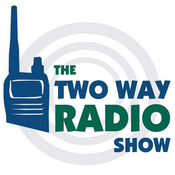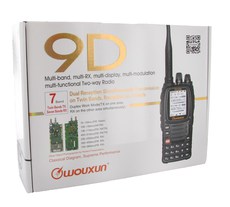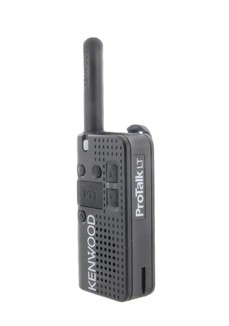 Kenwood introduced a business radio to the market that is a lot different from the other business two way radios in its product line. It's very small, very light and it is very simple to operate. However, don't let the small size fool you. This isn't just another tiny transceiver. This radio is definitely not a toy. It's the Kenwood PKT-23.
Kenwood introduced a business radio to the market that is a lot different from the other business two way radios in its product line. It's very small, very light and it is very simple to operate. However, don't let the small size fool you. This isn't just another tiny transceiver. This radio is definitely not a toy. It's the Kenwood PKT-23.
There are a number of benefits to choosing the PKT-23 over other Kenwood radios for business communications. Obviously, the biggest benefit is its size. It's about the size of a credit card and can fit in your pocket. This makes it an ideal choice for hospitality centers, retailers, and restaurants and is a logical alternative to other compact, light duty radios such as the Motorola CLS1110, CLS1410 and CLP Series radios, such as the CLP1010e and CLP1080e.
Like the CLS and CLP radios, the PKT-23 is designed for simplicity of operation and is indeed easy to carry and use. It has 4 channels, hands-free VOX, a stubby antenna to minimize its overall footprint and a PTT button on the front instead of the side for quick and ergonomically convenient access, although it is not as large and in-your-face as the PTT on the Motorola models.
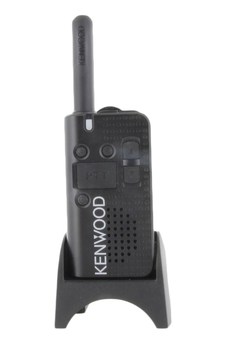 In comparison to its competitors, the PKT-23 is pretty powerful for its size. Most of the other radios of its size and class are generally limited to 1 watt. Kenwood has 1.5 watts in this radio, so it transmits with a little more power than you might expect. According to Kenwood, the PKT-23 should cover up to 250,000 square feet, and assuming it is true, that's considerably larger than some of the 1 watt competitors.
In comparison to its competitors, the PKT-23 is pretty powerful for its size. Most of the other radios of its size and class are generally limited to 1 watt. Kenwood has 1.5 watts in this radio, so it transmits with a little more power than you might expect. According to Kenwood, the PKT-23 should cover up to 250,000 square feet, and assuming it is true, that's considerably larger than some of the 1 watt competitors.
The Kenwood PKT-23 is also a durable radio. At first look it really doesn't seem that durable at all, in fact it really does look kind of toyish as far as how small and light it is. When one looks at a radio this size, one may not expect it to be able to withstand a lot of weathering or take a beating. But it definitely can. We do not get this radio back. We've carried the PKT-23 since it first launched in January 2014 and the return rate has been extremely low.
The PKT-23 meets military specifications 810c,d,e,f, and g, which are the same specifications met by higher end radios such as the Kenwood TK-3402 or the Icom IC-F4011. Those radios meet the same specs as this radio. For instance, the ports on this little radio are very well protected. You can notice that right away. There's a charge port and an accessory port on the very top of the radio with a sort of a rubberized cover over them, so it's clear they did that for waterproofing reasons.
This is an IP54 rated radio, which means its very dust and water resistant. It's not completely waterproof, which means it is not submersible, but that IP5 number indicates that it can take a reasonable amount of atmospheric moisture and can even withstand being out in the rain. Just don't drop it in the pool.
Another benefit to the PKT-23 is the micro USB type charger. In addition to being able to charge by sitting in a charging cradle, you can also plug in a standard micro USB cable and charge it that way. A lot of cell phones use the same type of charger, so that's a nice benefit. For example, you can a buy little "pocket charger" for your cell phone, and if you need a quick jump start on your phone while in a vehicle or somewhere away from an AC outlet, the little USB pocket charger can charge the battery on your cell phone or another USB device, such as your Kenwood PKT-23 Pocket Radio.
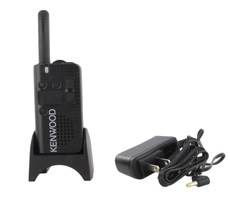 The PKT-23 does not take what you would consider a standard radio battery pack. This is more like a little cell phone size battery. It's a very thin battery that connects inside the radio with a little wire attached to the radio board. To access or replace the battery you must first remove the back of the radio. The battery is protected in a clear, plastic sleeve, presumably to make the battery somewhat waterproof. It is another indication that Kenwood is serious about ensuring the PKT-23 has considerable water resistance inside and out.
The PKT-23 does not take what you would consider a standard radio battery pack. This is more like a little cell phone size battery. It's a very thin battery that connects inside the radio with a little wire attached to the radio board. To access or replace the battery you must first remove the back of the radio. The battery is protected in a clear, plastic sleeve, presumably to make the battery somewhat waterproof. It is another indication that Kenwood is serious about ensuring the PKT-23 has considerable water resistance inside and out.
Now, the chassis quality of the PKT-23 is pretty good, but the display, well, there really is no display on this radio. That may be simply be a trade off for its tiny size. You don't really need a display for what it is designed for anyway. The general idea behind the PKT-23 was to keep it simple to operate, and it seems as though Kenwood did so. They certainly made it easy to change channels. There are up and down buttons on the front of the radio, and there's a voice announce, so when you change channels you'll hear the channel number announced. The menu is voice driven as well, so that sort of removes the need for a display altogether.
It may not have a display, but there is still a visual indicator, however simple. The PKT-23 has a multi-color LED, which is good for indicating what state the radio is in and what's going on with it. If you have a low battery, if you're receiving a transmission or transmitting, you'll see the light indicate that. Other than that there's really not a whole lot to it on the chassis itself.
As for audio quality, The PKT-23 does rather well, considering its small size. The reception is very clear, and within range, you don't get a lot of noise. Of course, the audio is not what you'd get on a larger radio like a ProTalk. This radio has a 300mw speaker, compared to a 500mw or 800mw speaker on a larger radio. But, like the lack of display, that was likely a size consideration as well. Also, considering the target vertical markets for this radio and the working environments in which radios of this type are utilized, most users of the PKT-23 will probably use it with a light headset or an earpiece. The speaker is just kind of a nice, added benefit.
The one big drawback to this radio is the accessory connector. Kenwood radios typically use a two pin connector, which is actually a huge advantage for Kenwood users, since this Kenwood two-pin connector, also known as a K1 connector, was adopted as a standard of sorts by a number radio manufacturers based in China. As such, accessories with a K1 connector are plentiful and sold at very reasonable prices.
Unfortunately, the PKT-23 doesn't use the standard K1 connector. it's a single pin 3.5mm connector and it's threaded, which means a standard 3.5mm audio accessory will not work, either. So if you have a fleet of Kenwood radios already and you have headsets, you're not going to be able to to use them with the PKT-23. It requires its own set of audio accessories, and the choices are very limited.
It is a drawback, but not unusual. We saw that with the CLP Series from Motorola as well. Motorola traditionally uses their own style of two pin connector on their business radios. When they came out with the CLP 1010 and 1040, they changed the connector type, most likely to accommodate the small form factor of the radios. Once again, with the Kenwood PKT-23, the decision to use a single pin connector is most likely due to a limitation in the amount of space available on the radio to accommodate such a connector.
However, this may only be a temporary drawback. The PKT-23 is still fairly new to the market. As these radios become more prevalent, third party manufacturers such as XLT, Impact and RocketScience may begin to take notice of this pocket sized portable and begin to offer some of their accessories with the PKT-23 audio connector as an option. It may just be a matter of time.
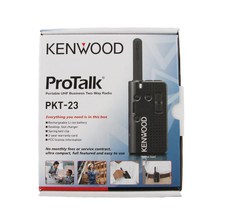 As for the price? The Kenwood PKT-23 is $144. Compared to other radios in its class, the PKT-23 is priced to be a contender. The Motorola CLP Series start at $199 for the one channel model and $219 for the four channel model. When you're looking at that you also have to take into consideration the total package. the Motorola radios include a headset priced at $25- $30. Although the PKT-23 doesn't include a headset, adding one to the 4 channel Kenwood package is still about $15-$20 cheaper than the one channel CLP radio. Kenwood isn't looking bad at all.
As for the price? The Kenwood PKT-23 is $144. Compared to other radios in its class, the PKT-23 is priced to be a contender. The Motorola CLP Series start at $199 for the one channel model and $219 for the four channel model. When you're looking at that you also have to take into consideration the total package. the Motorola radios include a headset priced at $25- $30. Although the PKT-23 doesn't include a headset, adding one to the 4 channel Kenwood package is still about $15-$20 cheaper than the one channel CLP radio. Kenwood isn't looking bad at all.
The Kenwood ProTalk LT PKT-23 Pocket-Sized Business Two Way Radio comes with the radio, lithium-ion battery, a belt clip, the fast charger, power supply, and a two year manufacturer warranty, so if anyone does have any concerns about this little radio getting busted up or not being able to take it, a two year warranty should put aside those fears somewhat. that's the same warranty that Kenwood has on their higher end, larger ProTalk line, such as the TK-3402. If Kenwood isn't worried about the durability of such a tiny radio for light business use, why should we be? The warranty indicates Kenwood has a lot of faith in this radio.
If you have any questions about the Kenwood PKT-23, don't hesitate to give us a call.
Hear our discussion of the Kenwood PKT-23 on The Two Way Radio Show Podcast in episode 78!
